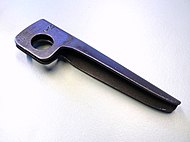
Back Скален клин Bulgarian Felshaken German Clavija (escalada) Spanish Pitoi (eskalada) Basque Piton French Chiodo da roccia Italian ハーケン (登山用品) Japanese Rotshaak Dutch Fjellbolt NB Hak (wspinaczka) Polish
| Part of a series on |
| Climbing |
|---|
 |
| Lists |
| Types of rock climbing |
| Types of mountaineering |
| Other types |
| Key actions |
| Key terms |

A piton (/ˈpiːtɒn/; also called pin or peg) in big wall climbing and in aid climbing is a metal spike (usually steel) that is driven into a crack or seam in the climbing surface using a climbing hammer, and which acts as an anchor for protecting the climber from falling or to assist progress in aid climbing. Pitons are equipped with an eye hole or a ring to which a carabiner is attached; the carabiner can then be directly or indirectly connected to a climbing rope.
Pitons were the original form of protection and are still used where there is no alternative. Repeated hammering and extraction of pitons damage the rock, and climbers who subscribe to the clean climbing ethic avoid their use as much as possible. With the popularization of clean climbing in the 1970s, pitons were largely replaced by faster and easier-to-use clean protection, such as nuts and camming devices.[1] Pitons are still found in place (as "fixed" pitons) on some established free climbing routes, as fixed belay station anchors, in places where nuts or cams do not work; and are used on some hard aid climbs.[2][3][4]
- ^ Loughman, Michael (1981). Learning to Rock Climb. Sierra Club Books. p. 78. ISBN 0-87156-281-2.
- ^ Loughman, Michael (1981). Learning to Rock Climb. Sierra Club Books. p. 80. ISBN 0-87156-281-2.
- ^ Genereux, Andy (May 2006). Yamnuska Rock: The Crown Jewel of Canadian Rockies Traditional Climbing. Rocky Mountain Books. p. 219. ISBN 9781894765749.
- ^ "Protection using pitons". Mountaineering Methodology. Retrieved 4 May 2017.